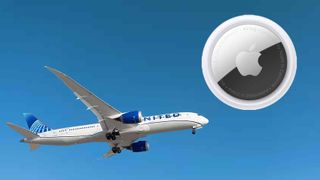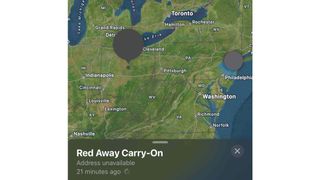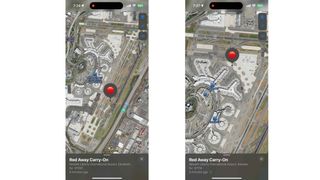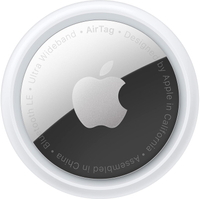My AirTag knew what United didn't – where in the world to find my bags
And I'll never travel without one again

Dear reader, it’s been an interesting week. On July 19, 2024, a CrowdStrike outage knocked out a ton of infrastructure, including core systems for airlines; some had it worse than others, though. Notably, Delta didn’t recover as quickly as American Airlines or United, as they canceled 1,000 flights alone on the 22nd.
However, by Monday, July 22, 2024, things were mostly back to operational, and I was prepped for a United flight out to Columbus, OH, to attend the MLS All-Star Game. I never made it there, but my luggage did.
After sitting for a while and failing to get a safe flight route due to “weather and operational” concerns, United canceled the flight. It wasn’t a fun result, but I thought I could get off and head back home. There was a wrinkle, though.
I usually travel with a backpack and a carry-on bag. Nestled inside a pocket within the interior of the latter is an AirTag – one that’s been with me since Apple announced the item tracker in 2021. I will never travel without one again and implore you to get one, too.
But instead of my usual carry-on strategy, I decided to check my bag – first mistake. When my flight was canceled, I was told to go down to baggage claim and find it. I quickly learned that wouldn’t happen. Curiously, I spotted on the FindMy app on my iPhone that the luggage was indeed off the plane.
I chatted with an agent near baggage claim and was told United would deliver my bag tomorrow … for free! It seemed like a nice, almost happily ever after ending. I told the agent my AirTag indicated the bag was nearby, but I was informed there was no “domestic retrieval.” I did keep my eye on the AirTag, though, and saw the bag bouncing around Newark Airport.
Hmm, that doesn’t seem right

To my surprise, the next day, the AirTag was back near a gate and soon moved onto a taxiway and then onto a runway. Then, I got an alert that it was in the middle of Ohio.
So rather than keeping my luggage in New Jersey, United had sent it on its way to Ohio. But here’s the thing: United’s bag-tracking system, which I’ve successfully used in the past, didn’t show any of this. I called United, and they told me my bag was still in NJ and would be delivered … until I told them I was tracking it with an AirTag, and they realized it had been loaded onto a flight to Ohio.
Without Apple’s AirTag, I would have had no idea of my bag's whereabouts. This process could have stretched out even further, or I may never have gotten my bag back at all. A representative also told me that there were around 5,000 bags at EWR alone – considering the recent outage and its disruptions, I don’t doubt that.
Faith in the AirTag and United

I spoke with another United representative on the phone, though, and thanks to the AirTag, we pinpointed when it arrived, and I confirmed it was safely there. I was then promised it would be on the next flight back. I kept an eye on the progress of my AirTag. It missed the first one but successfully made it on the last flight back from CMH to EWR, and I was able to track it as it went back to the gate, on the taxiway, on the runway, and then after 20 minutes of waiting for a fresh report from it, saw it was over Pennsylvania again.
I knew the flight number, so I was anxiously tracking it. Nearly in sync with the plane landing, FindMy began to update – see the screenshots below – but it went from the runway and then a long taxi, reaching the gate and then back at the baggage claim area of Newark Airport, Terminal C, where I first spotted it after my flight got canceled.
I drove over to the airport, and on the way, I received a concerning text from United reading: “We're still looking for your delayed bags…” I decided to ignore that, and once inside, I fired up FindMy on my iPhone and began using Precision Finding, which, once about 20 feet away, told me to go straight to the right, leading me to my bag next to the baggage claim. We finally reunited 24+ hours later.
I’ve never been more thankful to use an AirTag, so much so that I will never travel again without it, and even bought a few more this week. Most of the time, United’s bag tracking system works, but when it doesn’t, you’re completely in the dark. If I didn’t have an AirTag, I wouldn’t have known my bag wasn’t where the airline said it was, and it could have been days before I got it back.
It’s an essential carry-on for any air travel, whether for a carry-on that could get checked or a checked bag. While hopefully, you won’t need to rely on it the fact that it lives on Apple’s FindMy Network, which uses over a billion devices for an accurate location, the fact that it can provide turn-by-turn directions when you’re near it and that it’s safe for use on airplanes, makes it essential.
It's also an investment that's continued to provide value – a single AirTag is just $29 (or $99.99 for four of them), and when the battery goes, it's entirely user-replaceable with an off-the-shelf CR2032 battery. I've had that same AirTag since 2021 and have had to replace the battery every 12 to 14 months, depending on use. I've replaced it three times, and Apple promises about a year, but it varies slightly.
Apple AirTag: was $$29, $23.99 at Amazon
The AirTag is essential for any air travel, whether for a carry-on that could get checked or a checked bag. While hopefully, you won’t need to rely on it, the fact that it lives on Apple’s FindMy Network, which uses over a billion devices for an accurate location, the fact that it can provide turn-by-turn directions when you’re near it and that it’s safe for use on airplanes, makes it essential. You can also get a pack of four at $88.98, a 10% discount from the $99 MSRP.
You Might Also Like
Get the best Black Friday deals direct to your inbox, plus news, reviews, and more.
Sign up to be the first to know about unmissable Black Friday deals on top tech, plus get all your favorite TechRadar content.

Jacob Krol is the US Managing Editor, News for TechRadar. He’s been writing about technology since he was 14 when he started his own tech blog. Since then Jacob has worked for a plethora of publications including CNN Underscored, TheStreet, Parade, Men’s Journal, Mashable, CNET, and CNBC among others.
He specializes in covering companies like Apple, Samsung, and Google and going hands-on with mobile devices, smart home gadgets, TVs, and wearables. In his spare time, you can find Jacob listening to Bruce Springsteen, building a Lego set, or binge-watching the latest from Disney, Marvel, or Star Wars.
Most Popular


